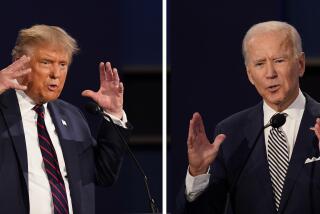News footage for the taking
- Share via
NEW YORK — During coverage of the space shuttle Columbia’s disintegration, the folks in CNN’s control room thought the picture they saw on rival Fox News Channel looked familiar.
So they tried an experiment.
The producers superimposed a tiny “CNN” logo on the upper left corner of the network’s screen as it showed the shuttle breaking into pieces. Blip! The same logo appeared on Fox News Channel.
Then they decided to abruptly switch cameras so a picture of correspondent Miles O’Brien appeared. For two seconds -- until it was replaced with a view of NASA’s mission control -- it looked like O’Brien was working for Fox too.
The shuttle disaster provided a vivid example of the lengths to which television networks sometimes go to get the most compelling pictures for a big story -- and an even more vivid example of the consequences if they don’t.
A Fox News Channel spokesman did not return a telephone call seeking comment.
As the Columbia flew over Texas on the morning of Feb. 1, Dallas station WFAA-TV followed its normal routine for fly-bys: A camera operator was assigned to capture the streak across the sky.
The picture appeared live on the air. But it wasn’t for several minutes, until NASA said it had lost contact with the shuttle’s crew, that it became clear what WFAA’s pictures revealed.
Several videos of the shuttle falling apart, both amateur and professional, eventually surfaced that day. But for a certain period as the nation awoke to the unfolding tragedy, WFAA’s pictures were the only ones available.
WFAA has affiliation agreements with both ABC and CNN. Television is a complex web of affiliations and exclusivity arrangements. Usually, they’re respected. But with satellite dishes, networks can pluck virtually any pictures out of the sky and often anything goes.
CBS used WFAA’s video in its report. The network politely asked for permission -- after the pictures had already appeared.
CBS News President Andrew Heyward argued that the concept of fair use -- the legal term for anything goes -- applies in cases of national emergencies.
“Every once in a while you have a piece of video that is so newsworthy you really can’t keep it off the air,” Heyward said. After the Sept. 11 terrorist attacks, network news division heads agreed that they all could use each other’s video.
CNN believes fair use applied for the shuttle story. But its executives are still annoyed at Fox.
“It’s a perfectly acceptable position for networks to take video from each other in times of national emergencies,” CNN spokeswoman Christa Robinson said, “but it’s rare that networks would go to such extremes to cover it up rather than give proper credit.”
As part of its agreement with WFAA, CNN took the expensive step of installing a fiber optic line that enabled it to pick up the station’s signal with the flip of a switch, said David Duitch, WFAA’s vice president of news.
ABC didn’t make the same investment, and instead made arrangements to get a special satellite transmission from WFAA that morning. But for 45 agonizing minutes, the satellite wasn’t working, ABC News spokesman Jeffrey Schneider said.
The consequences were profound. NBC had 8.7 million viewers between 9:30 a.m. and noon, CBS had 5.2 million and ABC had 3.5 million. More people saw CNN’s and Fox News Channel’s coverage than ABC’s, according to Nielsen Media Research.
For WFAA, its big moment is likely to live on. Duitch suspects he’ll see his station’s video in future documentaries about the space program, or perhaps a still picture in textbooks.
“I certainly hope they would credit WFAA,” he said. “But do I think that’s going to happen? Well, I’m not so certain.”
More to Read
The biggest entertainment stories
Get our big stories about Hollywood, film, television, music, arts, culture and more right in your inbox as soon as they publish.
You may occasionally receive promotional content from the Los Angeles Times.










